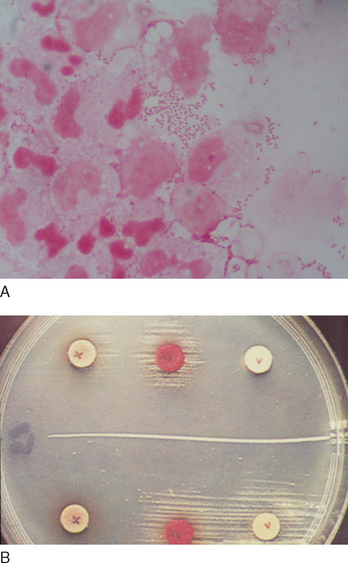CASE 8
A 64-year-old man presented to a clinic with complaints of low-grade fever, productive cough of yellow-green sputum, and worsening of his chronic shortness of breath for several days. He had recovered from a mild cold just before the current symptoms began.
LABORATORY STUDIES
Diagnostic Work-Up
Pneumonia can be reasonably excluded based on the absence of infiltrates on chest x-ray. Table 8-1 lists the likely causes of current illness (differential diagnosis). Investigational approach to delineating the etiology of the current episode may include
TABLE 8-1 Differential Diagnosis and Rationale for Inclusion (consideration)
Rationale: A clinical diagnosis of acute exacerbation of chronic bronchitis (AECB) should be considered. While many organisms can cause acute exacerbation of COPD, nontypable H. influenzae and S. pneumoniae make up a large majority of cases. M. catarrhalis is also seen and is indistinguishable from H. influenzae. S. pneumoniae is more likely to cause pneumonia. The respiratory viruses (e.g., influenza and adenovirus) are less likely to be productive of sputum.
MICROBIOLOGIC PROPERTIES
Haemophilus species are small, Gram-negative coccobacillary rods (Fig. 8-1A). The species implicated in human infections include H. influenzae, H. parainfluenzae, H. haemolyticus, and H. parahaemolyticus. These species are differentiated primarily by their requirements for X (heme) and V (nicotinamide adenine dinucleotide) factors. Species designated para– require V factor but not X factor for growth, whereas the others require either X and V (H. influenzae) or X only (see Fig. 8-1B). There are two different groups of H. influenzae, as determined by the presence or absence of a polysaccharide capsule. Encapsulated strains belong to group 1 and are subdivided into 6 subtypes (a, b, c, d, e, and f), based on the particular polysaccharide capsule. Unencapsulated strains belong to group 2 and are called nontypable H. influenzae (NTHi). All H. influenzae contain lipopolysaccharide (LPS) in the cell wall. H. influenzae type b (Hib) has a polyribitol phosphate capsule and in the past was the major (invasive) pathogen of this group (no association with the case; see Table 8-2 for a brief understanding of diseases caused by Hib). Group 2 (unencapsulated) strains are referred to as nontypable H. influenzae (NTHi) because they cannot be serotyped with antisera to the polysaccharide capsules. Gram-negative cell wall contains LPS with embedded endotoxin that is activated in body fluid when released in bacteremia and with other invasive infections.
Stay updated, free articles. Join our Telegram channel

Full access? Get Clinical Tree



